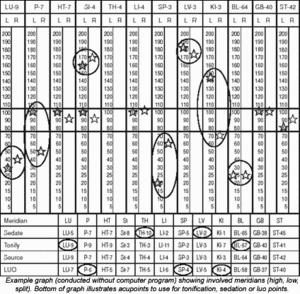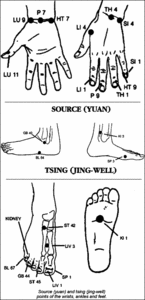Nakatani first developed the procedure of electronic evaluation of the meridian system by measuring skin conductance at the yuan (source) point of the wrist and ankle, creating one of the most significant acupuncture diagnostic methods. It is unrivaled in contemporary or traditional acupuncture. When one compares the findings of learned Asian masters of acupuncture using pulse diagnosis with the findings of ryodoraku, the meridians involved are identical. Masters of acupuncture are known to palpate the 12 pulse positions for as long as 15-30 minutes per wrist in select cases. Electronic evaluation of the 12 yuan points takes less than two minutes, regardless of the complications of the case.
Electronic measurement evaluation of the patient's yuan points does not determine the same indications seen as when the specific 28 pulse characteristics are analyzed via proper pulse diagnosis. It does, however, determine if an individual meridian has an excess or deficiency in comparison to the entire system average of the 12 primary meridians.
When one finds an elevated or deficient meridian using ryodoraku, the treatment approach is to specifically tonifiy or sedate the acupuncture points known to replenish or deplete biomag-netic energy. This action will create balance in the meridians. Electronic measurements are ascertained by examining the bilateral 24 specific yuan points of the wrist and ankles for only three seconds per point.
Ryodoraku is practiced by measuring the source point with an inexpensive instrument designed specifically for this purpose. By adding the measured values of each of the 12 meridian exam points together and dividing by 24 (representing the 12 bilateral meridians), the practitioner may develop a base average. The status of the meridians may be determined as being too high or too low in relation to the base average. In the mid-1980s, the art of electronic evaluation for diagnostic purposes in acupuncture used high technology by incorporating computer enhanced evaluation.
One of the most significant discoveries of ryodoraku was split meridians, which had never before been seen or described in the history of acupuncture. In pulse diagnosis, for example, the pulse of the spleen, lung and san jiao meridian is always found in the right wrist, whereas those of the gallbladder, kidney and liver are always analyzed in the left wrist. When one derives a diagnosis from the 28 pulse qualities, it can reveal a multitude of factors that can only be ascertained through the pulse. However, it cannot and does not reveal what ryodoraku has discovered.
Because ryodoraku evaluation utilizes measurements of the yuan points bilaterally, ryodoraku often reveals, especially in severe cases, meridians that exhibit a split in numerical value between left and right sides of the body. As ryodoraku measures the yuan points of both sides of the body, it is able to detect a diagnostic situation that was virtually unknown until ryodoraku's invention. By utilizing the Luo point of the split meridian, a correction can be made in a split (left-to-right) meridian. Luo points, classically and traditionally, are used to link a coupled meridian, such as that of the lung/large intestine. In auriculotherapy, this correction between splits can be treated by the master oscillation point.
Evaluation of the musculotendinous meridians seen in orthopedic conditions is ascertained by the same procedure, but using the tsing (jing-well) points. yuan and tsing point evaluation are two entirely different examinations of two different meridian systems.
In 1982, I gave ryodoraku a more contemporary, descriptive term: "electro-meridian imaging" (EMI). This electronic method of evaluation is reliable; duplicable; easy to learn and employ; and extremely simple to explain to patients. It is changing the way acupuncture is being used in therapy and diagnostics worldwide.
With EMI available to acupuncturists and physicians through computer enhanced imaging, it has become state-of-the-art to allow a trained technician or practitioner to conduct this significant diagnosis in less than two minutes. The computer hardware requirement is an easy-to-use, simple design that requires a computer with a minimum processor speed of 486K, and a Windows operating system. It is attractive, professional and impressive to doctors and patients. Referrals for this electronic acupuncture examination can be numerous to overwhelming. The typical Western patient exhibits much more confidence in this contemporary, electronic, computer-enhanced style of examination than ancient pulse diagnosis. It allows patients to take home a copy of their graphic interpretation, and diagnostic criteria. In addition, a copy of involved meridians may be printed, or a copy of specific points the patient may use at home to accelerate clinical response can be reproduced.
Space limits the full explanation of this procedure. Should any reader of this column wish a descriptive EMI booklet that shows the examination procedure, along with the computer screenshots from the software, simply email your request to me. You may also send your request directly to my columnist page (www.ChiroWeb.com/columnist/amaro). You may also leave a comment or ask a question by clicking on the "Talk Back" button.
John Amaro, DC, FIAMA, Dipl.Ac (IAMA), Diplo.Ac. (NCCAOM)
Carefree, Arizona
Click here for previous articles by John Amaro, LAc, DC, Dipl. Ac.(NCCAOM), Dipl.Med.Ac.(IAMA).







